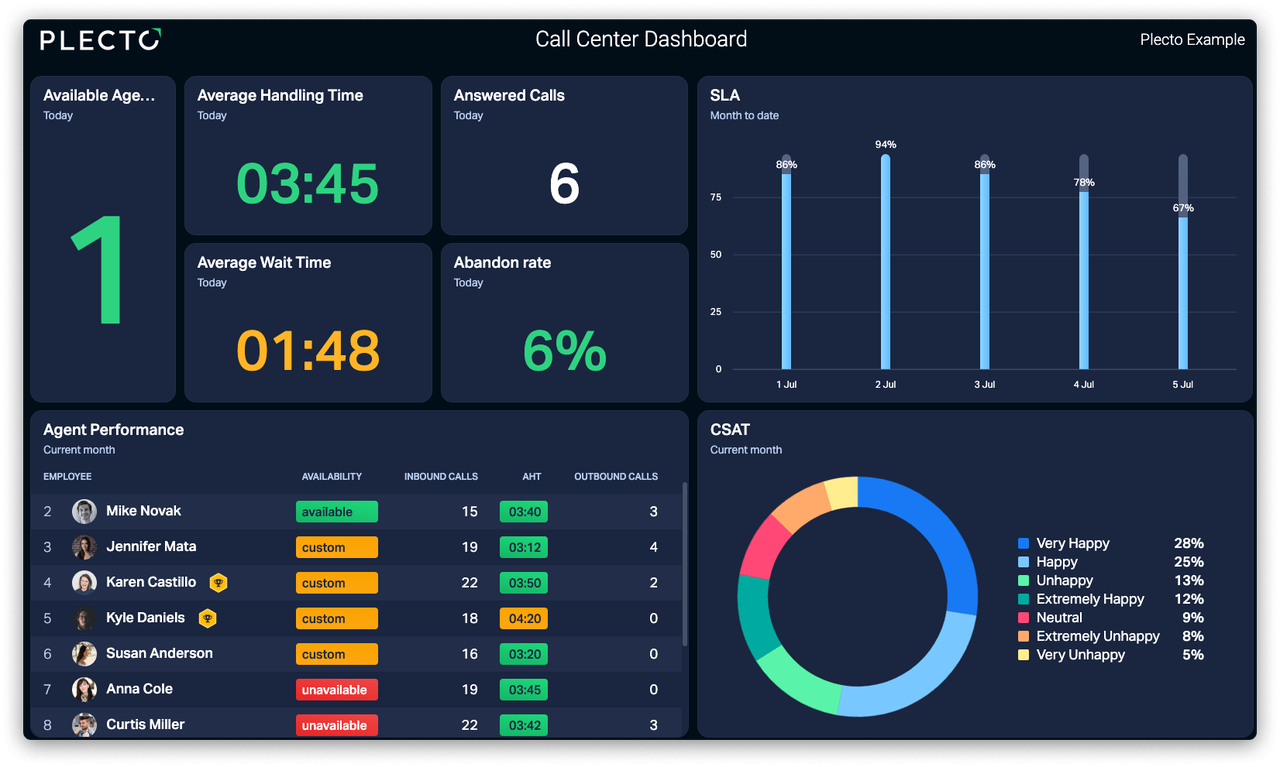Working in the fast-paced, demanding environment of a call or contact center requires juggling multiple tasks and skills at even the quietest of times. But when call volumes reach peak levels – such as during specific times of the day or the year – agents might struggle to keep up.
The result? More and more customers, frustrated and impatient, end up hanging up. It’s vital to understand that this phenomenon – known as “call abandonment” – is not simply a minor nuisance. If it’s not addressed and solved promptly, it can lead to damaging consequences for your business.
So, without further ado, let’s jump into today’s topic and discover more about call abandon rates and strategies to keep this number as low as possible.
Abandoned call: What it is and how to calculate your rate
First of all, let’s shed some light on call abandon rates and illustrate how to calculate yours. As we mentioned, a call is considered “abandoned” when the customer disconnects before reaching a call center agent.
As we will see shortly, there can be different reasons for this. What’s important to note is that a low level of abandoned calls is fairly normal and to be expected across most call centers. On average, an acceptable call abandon rate is between 5-8% of your total daily calls. Anything above that – and definitely, anything above 10% – should be addressed immediately.
Calculating your call center’s abandon rate (as a percentage) is easy. Just use the formula below:
Abandoned calls/Total number of calls x 100 = Call abandon rate
Let’s illustrate this with an example. If your daily number of received calls is 100 and 10 people disconnect before speaking to one of your agents, your call abandon rate is 10%. This is way too high, so something must be done.

The main reasons for abandoned calls
When you are faced with a high number of abandoned calls, day after day, it’s normal to start wondering: why is this happening? Here are some of the most common culprits
- Long waiting times: By far the most cited reason why customers abandon calls, waiting too long for an agent to pick up a query is a slippery slope to high call abandon rates
- Confusing IVR systems: If the instructions provided by your IVR system are complex, lengthy, and confusing, they might put off your customer who is trying to reach one of your agents.
- The inability to speak with a human agent: Perhaps your contact center services don’t currently offer the possibility to speak with a real, live agent. If that’s the case, you might risk a higher call abandon rate, as many people consider speaking to an agent a non-negotiable of call centers.
- Personal reasons: This is the only situation almost completely out of your control. Something might happen in the background that requires the caller’s full attention, leading them to abandon your call. While impossible to predict or prevent, it can be minimized by ensuring that all calls are attended to within a short timeframe.
Why Plecto is the perfect solution for your contact center
Are you managing a busy contact center and struggling to stay on top of your KPIs? Plecto centralizes your key KPIs on easy-to-understand dashboards on TVs for all the team to see. Whether it's reducing response time by 85% or increasing call efficiency by 50%, Plecto is built to improve your contact center's perform
Build your first dashboard.
Start your 14-day free trial today
Reducing your call abandon rate: Our five top tips
Let’s now review some of the best ways in which you can cut down your call abandon rate.

1. Leverage real-time monitoring
First of all, you’ll need to understand one important thing: to slash your abandoned call rate, you need to figure out when, exactly, customers are more likely to hang up when calling your contact center.
To achieve this, you’re going to have to monitor your calls currently on hold as well as the current waiting time. By looking at these two metrics, you’ll be able to establish specific goals and KPIs that guide you – and your team – towards a more efficient handling of calls.
For example, let’s imagine that your current average wait time for each call you receive daily is five minutes. You know that that’s too long because your current call abandon rate is 10%. So, you establish that calls need to be answered within two minutes. Anything above this threshold just won’t cut it.
If all this sounds too much for you, fear not – there are some exceptionally handy tools out there that automate all these tasks. Take Plecto, for example. Our real-time dashboards allow your teams to stay on top of your KPIs and service levels in real-time at the touch of a button, enabling them to act promptly and ensure your calls are attended to quickly, smoothly, and efficiently.
Build your first dashboard.
Start your 14-day free trial today
2. Offer a call-back option
As we’ll see shortly, one of the best ways to counteract high call abandon rates is equipping your call center with the right amount of staff, depending on the fluctuation of customer demand throughout the day.
In parallel to this, though, it’s also essential to leverage some helpful tech solutions. While you might already be using digital systems for outbound calls, such as call center preview dialers – handy tools that provide contact agents with important information about their contacts right before making a call – you should consider doing the same for your inbound calls.
In particular, you’ll want your IVR system to include a call-back option. This is a very simple feature that enables your first available agent to call back a customer if the wait time is too long. This way, your customer can go on with their day knowing that they will soon receive a call to deal with their query.
If you want to go the extra mile, you could even introduce a feature for your call-back service that lets your customers know roughly when they will be contacted by one of your agents. You could provide an estimated timeframe or even arrange for a specific slot.
While all this may sound ideal, a call-back service is not always a silver bullet, especially if you regularly deal with massive call volumes. In this case, offering a callback to every single customer may end up delaying calls and putting a strain on your operations even further.
3. Provide rough waiting times
The uncertainty surrounding when a call will be answered is one of the biggest causes of frustration for customers. Unsurprisingly, it’s also high on the list of reasons why customers hang up after being on hold for a while.
You can remedy this quite easily by letting customers know their estimated waiting time. One of the most popular ways to do so is by introducing a queuing system. Through this, you can let customers know where in the queue they currently are. In turn, this enables them to work out how much longer they’ll need to stay on the line before speaking to an agent.

4. Review your staffing levels
We mentioned this earlier: inadequate staffing levels might be one of the reasons why your call abandon rate is so high. If this is the case, the solution is straightforward: you’re going to have to revise your current staffing distribution levels as well as potentially consider hiring more people.
Use digital tools to identify the busiest times of the day and days of the week, and make sure you are fully staffed at those crucial moments. Importantly, keep reviewing this as things might change month by month, especially during times such as the summer holidays and Christmas.
But what if some of your staff work remotely? In this case, to ensure they have everything they need to attend to the calls they receive, it’s important that you equip them with the right digital solutions, whether it be RealVNC's remote desktop application for MAC (if they are a Mac user) or other remote access solutions for their own devices.

5. Support your staff with AI solutions
As we touched on earlier, providing your team with the latest call center systems technology is very helpful when it comes to taking those call abandon rates down. Specifically, you might want to incorporate some artificial intelligence (AI) tools, such as conversational AI.
This includes solutions such as live chat and virtual assistants that support customers in real-time, offering a more pleasant and streamlined experience. Conversational AI has come in leaps and bounds in the past few years, and we can safely say that it’s only getting better, more personalized, and more effective.
There are many conversational AI solutions out there (most can be easily identified by their ai TLD), each one offering slightly different features, so it’s up to you to assess your contact center’s needs and pick the best one for you.
Key takeaways
Contact centers are busy, bustling environments where every second counts. So much so that only a bunch of seconds could be what makes or breaks your call abandon rates. In this guide, we talked about the importance of keeping a low call abandon rate, and we looked at six ways to help your team achieve this.
While equipping your call center with skilled staff is, of course, paramount, another vital aspect is technology. Tools such as those offered by Plecto can enable your team to set specific KPIs around service levels and wait times, as well as monitor your performance and develop ad-hoc ways to improve it. Check out Plecto’s offering and discover how it can supercharge your contact center team.
Alwayne Powell is an experienced performance marketing leader with an extensive background in the digital space, working client and agency side to provide paid search, SEO and CRO solutions in the B2B and B2C sectors. They are the current Senior Digital Marketing Manager at leading communication platform provider 8x8. Alwayne has written for other domains such as Startupguys.net and Cleverism. You can find them on LinkedIn.




